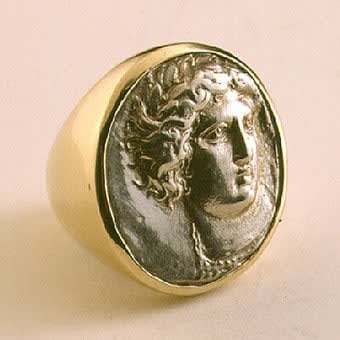Silver Tetradrachm from Amphipolis, 354 BCE - 353 CE
Silver-Gold
FJ.5114
Possibly an 18th -19th century copy of the original. Amphipolis was founded by Athens in 437 B.C. But fell under the power of the Macedonian king Philip II, father of...
Possibly an 18th -19th century copy of the original.
Amphipolis was founded by Athens in 437 B.C. But fell under the power of the Macedonian king Philip II, father of the famous Alexander the Great, in 357 B.C. From the middle of this period, the city produced a magnificent series of tetradrachms, as evidenced in this stunning silver coin. On the obverse side a stunning portrait of Apollo is depicted. As the Greek sun god Apollo was one of the twelve original Olympian gods. Born the son of Zeus on the island of Delos, he was raised by Poseidon. As well as being a solar god to the Greeks, Apollo was also the god of fine arts, medicine, music, poetry and eloquence. Both his fame and spirited powers have come down through the ages, inspiring such eloquent English authors as Milton, Shakespeare and Spencer. The reverse side of this ancient silver coin features a lighted torch which alludes to the torch races held at Amphipolis in honor of Apollo. The inscribed square band that surrounds the torch is reminiscent of the square reverse punches of archaic coinage, a motif that remained for a relatively long period of time on Macedonian coinage. Mounted in a regal gold ring, a setting that truly befits this spirited work of art, this silver tetradrachm of Amphipolis magically transports us back to an age when the Macedonians wielded an enormous amount of power and created a material culture equal in its vitality and beauty.
Amphipolis was founded by Athens in 437 B.C. But fell under the power of the Macedonian king Philip II, father of the famous Alexander the Great, in 357 B.C. From the middle of this period, the city produced a magnificent series of tetradrachms, as evidenced in this stunning silver coin. On the obverse side a stunning portrait of Apollo is depicted. As the Greek sun god Apollo was one of the twelve original Olympian gods. Born the son of Zeus on the island of Delos, he was raised by Poseidon. As well as being a solar god to the Greeks, Apollo was also the god of fine arts, medicine, music, poetry and eloquence. Both his fame and spirited powers have come down through the ages, inspiring such eloquent English authors as Milton, Shakespeare and Spencer. The reverse side of this ancient silver coin features a lighted torch which alludes to the torch races held at Amphipolis in honor of Apollo. The inscribed square band that surrounds the torch is reminiscent of the square reverse punches of archaic coinage, a motif that remained for a relatively long period of time on Macedonian coinage. Mounted in a regal gold ring, a setting that truly befits this spirited work of art, this silver tetradrachm of Amphipolis magically transports us back to an age when the Macedonians wielded an enormous amount of power and created a material culture equal in its vitality and beauty.
